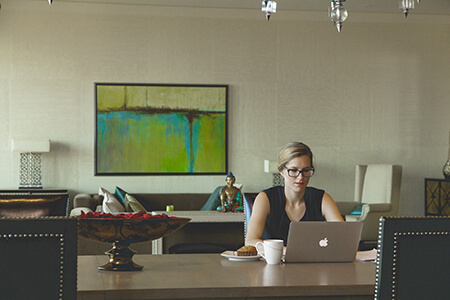Deducting Household Expenses for Home Business

You are probably aware that expenses you incur solely for the benefit of your business reduce your taxable revenue. For example, suppose you own a home-based business that purchases picture frames at the wholesale price of $1 each and resells them for $5 each. If you sell 100 picture frames, your gross revenue is $500, but this is offset by the $100 you paid to purchase the frames. Of course, there are other expenses that can further reduce your taxable income, including the cost of inbound and outbound shipping, the boxes you purchased for shipping the frames to your customers, and the packing peanuts or bubble wrap you bought to ensure the frames arrived at their destinations intact.
There are also many other expenses that can offset your taxable revenue. Typically, these include the fees paid for a virtual address that you can use as your business address, the salaries you pay your employees, raw materials used to manufacture the products you sell, and the fees you pay to your accountant or bookkeeping service. One potential deduction that is often overlooked is the deduction for certain expenses related to your home.
This deduction is rather complex, so it is best to discuss your specific situation with the accountant or attorney who handles your business affairs. However, the following information can help you understand the basic requirements, the types of documentation you may need to assemble, and the questions that you will need to ask. The information provided should not be construed as tax or legal advice, and you should also keep in mind that tax laws are subject to change. Furthermore, the following discussion is aimed primarily at those operating as sole proprietors rather than another type of business structure.
Qualifications
According to the Internal Revenue Service’s Publication 587, you must use an area in your home exclusively for your business. The area does not have to be an entire room, but it does need to identifiable as a separate space that is not used for any other purpose. For example, if you place your desk in a den that is also the room used by your family for watching television, playing games, or entertaining friends, you cannot meet the test for exclusive use. However, there are exceptions to the rule, including a shared space that is used to store inventory for your business. In addition, a barn, greenhouse, workshop, or other structure that is not attached to your home can qualify as a separate space if it is used exclusively for your business. One example would be a free-standing workshop that you only use to manufacture the products that you sell.
The second qualification is that you must be engaged in a business or trade. You cannot take a home deduction simply because you engage in profit-seeking activities. To illustrate, suppose you use your den to track the stocks in your personal portfolio, search for a bank paying a better interest rate than your current bank, or review statements from the broker managing your personal investments. You are not conducting these activities as a trade or business, so you would not qualify.
Another important test is determining whether your home is your principal business location. If your home is the only fixed location in which you handle administrative tasks for your business, you should pass this test. Administrative tasks include preparing invoices and statements for customers, making appointments, preparing reports, handling your bookkeeping chores, and ordering inventory or supplies. If you travel extensively and conduct administrative tasks from hotel rooms or other places that are not fixed locations, you can still pass this test. Furthermore, you do not have to spend all of your working hours at home to qualify. For example, if you are a self-employed electrician, plumber, or roofer, you deliver your services at the customer’s location. Since you perform your work at many different sites that are not fixed locations, you can still pass the test.
Examples of Deductions for a Home Business
The IRS breaks home-related expenses into three categories: direct, indirect, and unrelated. A direct expense is one that relates only to the portion of your home that is used exclusively for your business activities, and you can usually deduct direct expenses in full. Unrelated expenses are not deductible. To illustrate the difference, suppose two windows in your home are shattered by hail. One window is in the room that you use exclusively for your home-based business, and the other window is in your child’s bedroom. You can deduct the cost of replacing the window in your home office as a direct expense, but you cannot deduct the cost of replacing the other window because it is unrelated to your business activities. Similarly, if the broken window necessitates repainting the two rooms, you can only deduct the portion for repainting your home office.
Indirect expenses are those that you incur for maintaining, operating, or protecting your entire home. These include electricity and other utilities, general repairs, insurance, and dues paid to your homeowner association. Because these expenses benefit the entire home, you can only deduct the portion that relate to your qualified space.
The traditional method for determining the portion of an indirect expense you can deduct is to find the percentage of your home’s total square footage that is exclusively used for your business. This percentage is then applied to each allowable deduction. The IRS will usually accept any method for determining the percentage as long as it is logical and reasonably accurate. For example, if your home has five rooms and all are equivalent in size, you could say that the single room devoted to your business represents 20% of your entire home, so you could deduct 20% of each allowable indirect expense. Alternatively, you could divide the square footage of the space used exclusively for your business by the total square feet contained within your home. Suppose your home contains a total of 2,000 square feet, and your business occupies 600 square feet. Dividing 600 by 2,000 reveals that 30% of your home is devoted to your business, so you could claim 30% of the allowable indirect expenses.
If the premiums to insure your home total $2,000, using the second method would allow you to deduct $600 as an indirect expense. If you pay $800 to repair your home’s central heating and cooling system and use the first method, the allowable indirect expense would be $160.
Keep in mind that any expense for which your business is billed separately should qualify as a direct expense that you can deduct in full. For example, if your business space has an independent utility meter, heating and cooling system, or security system, you could probably deduct the total monthly charges or bills for repairing or maintaining the systems in full. However, you would not be entitled to also deduct a percentage of the same expenses that cover the rest of your home.
The simplified method is a bit less time-consuming, but it has some limitations. Under this method, you multiply the square feet contained in your business space by the rate prescribed by the IRS, which is currently $5. The size of the space cannot exceed 300 square feet, and you must use the actual square footage of the business space if it is less than 300 square feet. At the current rate, the maximum deduction would be $1,500. Your accountant or tax preparer should evaluate both methods to determine which one is right for your specific situation.
Closing Thoughts
Taxes can be complicated, and there are rules and nuances that are not included in the above sections. Only a qualified professional can advise you on the issues involved in claiming a deduction for home expenses related to your business.



